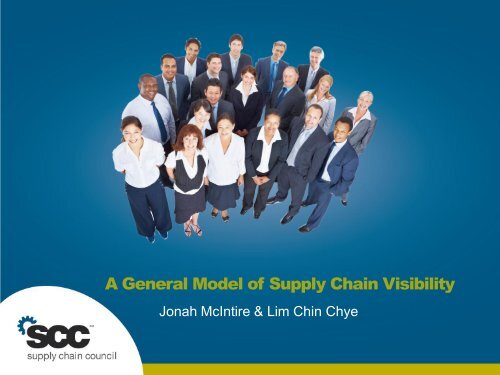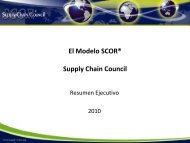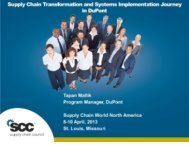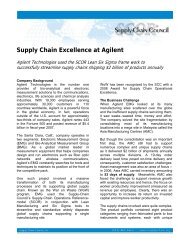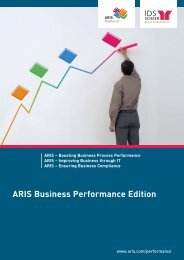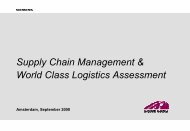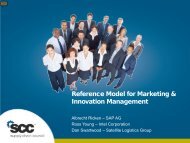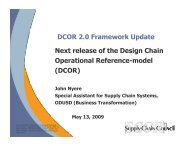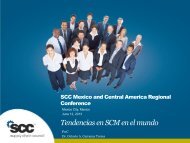A General Model of Supply Chain Visibility - Supply Chain Council
A General Model of Supply Chain Visibility - Supply Chain Council
A General Model of Supply Chain Visibility - Supply Chain Council
Create successful ePaper yourself
Turn your PDF publications into a flip-book with our unique Google optimized e-Paper software.
A <strong>General</strong> <strong>Model</strong> <strong>of</strong> <strong>Supply</strong> <strong>Chain</strong> <strong>Visibility</strong><br />
Jonah McIntire & Lim Chin Chye<br />
© 2010 <strong>Supply</strong> <strong>Chain</strong> <strong>Council</strong>. ALL RIGHTS RESERVED. | < filename > | Slide 1 | 16 November 2010
Contents<br />
1<br />
Who is Haier<br />
2<br />
<strong>Supply</strong> <strong>Chain</strong> Innovations<br />
3<br />
<strong>Supply</strong> <strong>Chain</strong> <strong>Visibility</strong><br />
4<br />
Q& A<br />
© 2010 <strong>Supply</strong> <strong>Chain</strong> <strong>Council</strong>. ALL RIGHTS RESERVED. | < filename > | Slide 2 | 16 November 2010
Who is Haier<br />
Haier is the World #1 Brand <strong>of</strong> Major Home Appliances<br />
The world leading business intelligence firm Euro-monitor International has ranked<br />
Haier #1 Brand <strong>of</strong> Major Appliances 2009 by brand shares (by global brand name), it<br />
also place Haier’s refrigeration appliances and Haier’s home laundry appliances #1 by<br />
global brand name.<br />
© 2010 <strong>Supply</strong> <strong>Chain</strong> <strong>Council</strong>. ALL RIGHTS RESERVED. | < filename > | Slide 3 | 16 November 2010
Who is Haier<br />
In the 50 Most Innovative Companies 2010 Listing by Business week<br />
• In April 2010, Business Week <strong>of</strong> US published The 50 Most Innovative Companies 2010 in<br />
the world, which included 5 Chinese companies, and Haier ranked No. 28 as the only<br />
Chinese home appliances brand.<br />
© 2010 <strong>Supply</strong> <strong>Chain</strong> <strong>Council</strong>. ALL RIGHTS RESERVED. | < filename > | Slide 4 | 16 November 2010
Who is Haier<br />
Historic growth <strong>of</strong> Haier’s Turnover (1984-2009)<br />
In year 2009, Haier Group achieved a global turnover <strong>of</strong> up to RMB124.3<br />
billion or USD18.2 billion , and the pr<strong>of</strong>it growth is 10 times the revenue<br />
growth.<br />
© 2010 <strong>Supply</strong> <strong>Chain</strong> <strong>Council</strong>. ALL RIGHTS RESERVED. | < filename > | Slide 5 | 16 November 2010
Who is Haier<br />
The Most Valuable Brand in China<br />
Historic growth <strong>of</strong> Haier Brand Value(1995-2009)<br />
Brand value 81.2<br />
billion RMB in 2009<br />
December 2 nd 2009,China’s Most Valuable Brands List for 2009 was<br />
released in New York. Haier is valued at RMB 81.2 billion RMB, topped<br />
all Chinese brands for the 8th consecutive year.<br />
© 2010 <strong>Supply</strong> <strong>Chain</strong> <strong>Council</strong>. ALL RIGHTS RESERVED. | < filename > | Slide 6 | 16 November 2010
Haier Global Presence<br />
Worldwide Network Overseas Global<br />
Trading Company 19 61<br />
Design Center 5 8<br />
Manufactory 24 29<br />
Industrial Park 4 16<br />
Sale Network 45800 58800<br />
© 2010 <strong>Supply</strong> <strong>Chain</strong> <strong>Council</strong>. ALL RIGHTS RESERVED. | < filename > | Slide 7 | 16 November 2010
Overview <strong>of</strong> Haier <strong>Supply</strong><br />
<strong>Chain</strong><br />
Products and solutions<br />
World Class <strong>Supply</strong> <strong>Chain</strong><br />
Global Customers<br />
• Refrigerator, freezer, airconditioner,<br />
washing<br />
machines, TV, water<br />
heaters, kitchen<br />
appliances…….<br />
• Over 20,000 new products<br />
every year<br />
• 16 Industrial parks<br />
• 29 manufacturing plants<br />
• Over 800 suppliers<br />
• 24,000 employees<br />
• Products sold in 178<br />
countries<br />
• 58,880 sales and<br />
support partners<br />
© 2010 <strong>Supply</strong> <strong>Chain</strong> <strong>Council</strong>. ALL RIGHTS RESERVED. | < filename > | Slide 8 | 16 November 2010
Haier Global Manufacturing Networks<br />
Italy<br />
USA<br />
Algeria<br />
Tunis<br />
Jordan<br />
Syria<br />
Iran<br />
India<br />
Pakistan<br />
Bengal<br />
中 国 青 岛<br />
China<br />
Qinqdao<br />
Cuba<br />
Nigeria<br />
Thailand<br />
Global MFG Sites<br />
16 Industrial Parks<br />
29 manufacturing plants<br />
© 2010 <strong>Supply</strong> <strong>Chain</strong> <strong>Council</strong>. ALL RIGHTS RESERVED. | < filename > | Slide 9 | 16 November 2010
Haier <strong>Supply</strong> <strong>Chain</strong> Innovation<br />
Strategic<br />
Objectives<br />
<strong>Supply</strong> <strong>Chain</strong><br />
Operations<br />
<strong>Supply</strong> <strong>Chain</strong><br />
<strong>Visibility</strong><br />
1. Strategic Objectives<br />
2. <strong>Supply</strong> <strong>Chain</strong> Operations<br />
• Enterprise Innovations<br />
• <strong>Supply</strong> <strong>Chain</strong> Innovations<br />
• Process Innovations<br />
• <strong>Supply</strong> <strong>Chain</strong> Performance<br />
3. <strong>Supply</strong> <strong>Chain</strong> <strong>Visibility</strong><br />
• Defining visibility as a process<br />
• A general visibility model<br />
• A visibility effectiveness model<br />
© 2010 <strong>Supply</strong> <strong>Chain</strong> <strong>Council</strong>. ALL RIGHTS RESERVED. | < filename > | Slide 10 | 16 November 2010
Strategic Objectives : Pr<strong>of</strong>itable Growth<br />
<strong>Supply</strong> <strong>Chain</strong> Excellence: Service Level, Returns, Employee Satisfaction<br />
Delivery to First Commit<br />
(DTFC)<br />
TAT (OTD)<br />
Inventory Turn(DOI)<br />
Upside, Downside<br />
Predictability Velocity Flexibility<br />
External : Customer<br />
Service Level<br />
Internal:<br />
Efficiency, Returns<br />
Reference to<br />
SCOR model<br />
Return on Assets<br />
• Predictability<br />
• Velocity<br />
• Flexibility<br />
• Gross Margin<br />
• Return on working capital<br />
• Return on Assets<br />
ROA<br />
ROA= (Rev-Cost)<br />
Asset<br />
100%<br />
ROWC<br />
© 2010 <strong>Supply</strong> <strong>Chain</strong> <strong>Council</strong>. ALL RIGHTS RESERVED. | < filename > | Slide 11 | 16 November 2010<br />
90%<br />
80%<br />
20<br />
70%<br />
15<br />
60%<br />
10<br />
5<br />
50%<br />
Return on<br />
working capital<br />
% ROWC= (Rev-Cost)<br />
(Inv+AR-AP)<br />
15<br />
14<br />
16<br />
18<br />
20<br />
22<br />
<strong>Supply</strong><br />
<strong>Chain</strong><br />
Excellence<br />
5<br />
10<br />
15<br />
20<br />
0%<br />
40<br />
%<br />
20%<br />
45<br />
40%<br />
60%<br />
50<br />
55<br />
80%<br />
60<br />
100%<br />
65<br />
GM=<br />
Customers<br />
Enterprise<br />
Employees<br />
Gross Margin<br />
GM<br />
(Rev-Cost)<br />
Rev<br />
%<br />
Pr<strong>of</strong>itable<br />
Growth<br />
Revenue<br />
Pr<strong>of</strong>it<br />
Mkt Share<br />
Customer,<br />
Employee’s<br />
Satisfaction
Suppliers<br />
Customers<br />
Haier Enterprise Innovations<br />
Enterprise and Business <strong>Model</strong> Transformations<br />
Leader in the era <strong>of</strong> “Internet <strong>of</strong> Things”<br />
Goals<br />
目 标<br />
低<br />
Low Cost<br />
高<br />
High<br />
Quality<br />
1. Enterprise Transformation<br />
From Manufacturing to Services<br />
快<br />
High<br />
Speed<br />
Proposition<br />
定 位<br />
On-demand<br />
Manufacturing<br />
and Delivery<br />
Virtual- physical<br />
networks<br />
Integration<br />
<strong>Model</strong><br />
模 式<br />
Customer Value<br />
Creation<br />
2. Business <strong>Model</strong> Transformation<br />
Inverted-Triangle<br />
Organization<br />
Autonomous<br />
Operating Units<br />
© 2010 <strong>Supply</strong> <strong>Chain</strong> <strong>Council</strong>. ALL RIGHTS RESERVED. | < filename > | Slide 12 | 16 November 2010
Haier Enterprise Innovations<br />
Inverted-Triangle Organization and Autonomous Operating<br />
Units<br />
Traditional<br />
Triangle<br />
Organization<br />
Management<br />
Give Orders<br />
users<br />
用 户 1<br />
user1<br />
用 户 2<br />
user2<br />
用 户 3<br />
user3<br />
用 户 4<br />
user4<br />
用 户 5<br />
user5<br />
……<br />
First Line Employees<br />
用 户 n<br />
usern<br />
Supporting<br />
Platforms<br />
Supporting<br />
platforms<br />
users<br />
用 户 1<br />
user1<br />
First Line Employees<br />
用 户 2<br />
user2<br />
用 户 3<br />
user3<br />
用 户 4<br />
user4<br />
用 户 5<br />
user5<br />
……<br />
用 户 n<br />
usern<br />
Provide<br />
Resources<br />
Management<br />
Haier’s<br />
Inverted-Triangle<br />
Organization<br />
• Internal Centric<br />
• Management Driven<br />
• Giving Orders<br />
• Being Managed<br />
• Internal Arguments<br />
Haier Organization<br />
Innovations<br />
同 一 目 标 、 端 到 端 、 倒 逼 体 系<br />
© 2010 <strong>Supply</strong> <strong>Chain</strong> <strong>Council</strong>. ALL RIGHTS RESERVED. | < filename > | Slide 13 | 16 November 2010<br />
• External Focus<br />
• Customer Driven<br />
• Providing Resources<br />
• Self-driven<br />
• 2-ways Collaboration<br />
Common Goal, End to End, Mutual Commitment
Target<br />
Process<br />
People<br />
Strategic Processes<br />
Strategic Resources<br />
Strategic Objectives<br />
Strategy<br />
Goals<br />
Haier Enterprise Innovations<br />
Inverted-Triangle Organization and Autonomous Operating<br />
Units<br />
以 创 造 客 户 价 值 为 核 心 , 以 倒 三 角 组 织 结 构 为 基 础 , 承 接 零 库 存 下 的 即 需 即 供 模 式 , 创 新 敏 捷 灵<br />
活 的 供 应 链 资 源 平 台 , 提 升 达 成 战 略 绩 效 的 能 力 , 建 立 “ 人 单 合 一 ” 双 赢 的 文 化 , 成 为 服 务 领 先 的<br />
精 益 供 应 链 .<br />
高 增 长<br />
高 增 值<br />
倒<br />
逼<br />
体<br />
系<br />
定<br />
单<br />
履<br />
约<br />
产<br />
能<br />
负<br />
荷<br />
一 线 经 营 体<br />
冰 箱 SC<br />
DTFC:%<br />
09 10 11 12<br />
一 线 经 营 体<br />
洗 衣 机 SC<br />
Autonomous<br />
Operating Units<br />
自 主 经 营 体<br />
STFC:%<br />
09 10 11 12<br />
中 一 中 二 特 冰<br />
定 单 保 障 的 资 源 与 机 制<br />
一 线 经 营 体<br />
电 热 SC<br />
ODC:%<br />
09 10 11 12<br />
定 单 /JIT/ 生 产 / 战 略<br />
平 台<br />
PL SC 长<br />
冰 箱 SC 洗 衣 机 SC 。。。。<br />
定 单 支 持 平 台<br />
生 产 支 持 平 台<br />
采 购 支 持 平 台<br />
零 物 耗 平 台<br />
流 程 创 新 平 台<br />
战 略 创 新 平 台<br />
09 10 11 12<br />
一 线 经 营 体<br />
厨 电 SC<br />
。。。。<br />
OTD: 天<br />
DOI: 天<br />
09 10 11 12<br />
定 单 保 障 的 竞 争 力<br />
一 线 经 营 体<br />
住 宅 SC<br />
。。。。<br />
UMC: 元 / 台<br />
09 10 11 12<br />
。。。。<br />
质<br />
量<br />
零<br />
缺<br />
陷<br />
日<br />
清<br />
体<br />
系<br />
Self-Innovating<br />
Self-Driven<br />
Self-Operating<br />
自 创 新 , 自 驱 动 , 自 运 转<br />
倒 逼 资 源<br />
© 2010 <strong>Supply</strong> <strong>Chain</strong> <strong>Council</strong>. ALL RIGHTS RESERVED. | < filename > | Slide 14 | 16 November 2010<br />
BU SC 长<br />
资 源 保 障
Haier <strong>Supply</strong> <strong>Chain</strong> Innovations<br />
Suppliers<br />
Factories /suppliers<br />
Collaborations<br />
Demand and <strong>Supply</strong><br />
Collaborations<br />
• End to End<br />
• Closed Loop<br />
• Collaborations<br />
Reference to<br />
SCOR model<br />
© 2010 <strong>Supply</strong> <strong>Chain</strong> <strong>Council</strong>. ALL RIGHTS RESERVED. | < filename > | Slide 15 | 16 November 2010<br />
Customers<br />
Collaborations<br />
Users
3.Order creation<br />
4.Planning<br />
5.Scheduling<br />
Haier <strong>Supply</strong> <strong>Chain</strong> Process Innovations<br />
2.Return to forecast<br />
4. 预 排 产<br />
备 资 源<br />
3. 周 资 源<br />
确 定<br />
1.Demand Forecast<br />
2. 客 户 进 销<br />
存 分 析<br />
Demand –<strong>Supply</strong> Collaboration<br />
1. 零 售 预<br />
测 提 报<br />
Year target<br />
Month Target<br />
Week target<br />
Demand Generation<br />
5. 零<br />
售 需<br />
求 提<br />
报<br />
6. 客<br />
户 进<br />
销 存<br />
分 析<br />
7. 确<br />
认 定<br />
单<br />
8. 订<br />
单 满<br />
足 方<br />
案<br />
9. 时<br />
序 排<br />
产<br />
10. 时<br />
序 配<br />
车<br />
Order Collaboration<br />
Plan/Schedule<br />
T Week<br />
T-1<br />
T-2<br />
11.<br />
时 序<br />
发 布<br />
6.Material<br />
Manufacturing<br />
12.<br />
时 序<br />
交 接<br />
7.Build<br />
Total <strong>Supply</strong><br />
<strong>Chain</strong> <strong>Visibility</strong><br />
13.<br />
时 序<br />
生 产<br />
14.<br />
时 序<br />
拣 配<br />
8.Ship<br />
Logistics<br />
15. 时<br />
序 装<br />
车<br />
16.<br />
时 序<br />
发 货<br />
9.Deliver<br />
Domestic<br />
overseas<br />
L1/2 shops<br />
L3/4 shops<br />
Specialty shop<br />
Large Format<br />
Stores<br />
Hyper Marts<br />
Super Marts<br />
17.<br />
客 户 签 收 返 单<br />
Retail<br />
Corporate contracts<br />
Overseas channels<br />
Pro<strong>of</strong> <strong>of</strong> delivery<br />
End Users<br />
T-3<br />
© 2010 <strong>Supply</strong> <strong>Chain</strong> <strong>Council</strong>. ALL RIGHTS RESERVED. | < filename > | Slide 16 | 16 November 2010
Haier <strong>Supply</strong> <strong>Chain</strong> Performance<br />
Volume Growth Delivery Predictability Delivery Turn-around Time<br />
+23%<br />
+197%<br />
–32%<br />
30<br />
07 年 08 年 09 年 10 年 9 月<br />
Unit Volume<br />
Total SC Cost<br />
30<br />
08 年 底 09 年 中 09 年 底 10 年 9 月<br />
Delivery to 1 st commit<br />
Inventory - Raw<br />
30<br />
08 年 底 09 年 中 09 年 底 10 年 9 月<br />
Order to<br />
Delivery<br />
Inventory - FG<br />
30<br />
–16%<br />
30<br />
–75%<br />
30<br />
–43%<br />
08 年 底 09 年 中 09 年 底 10 年 9 月<br />
Cost per unit<br />
08 年 底 09 年 中 09 年 底 10 年 9 月<br />
Days <strong>of</strong> Inventory<br />
08 年 底 09 年 中 09 年 底 10 年 9 月<br />
Days <strong>of</strong> Inventory<br />
© 2010 <strong>Supply</strong> <strong>Chain</strong> <strong>Council</strong>. ALL RIGHTS RESERVED. | < filename > | Slide 17 | 16 November 2010
Conclusions and Learning<br />
Business<br />
Objectives<br />
Haier achieve supply chain<br />
excellence through innovations<br />
and focus on customers needs.<br />
<strong>Supply</strong> <strong>Chain</strong><br />
Operations<br />
Utilizing SCOR model enable<br />
supply chain collaborations and<br />
improve operations performance.<br />
<strong>Supply</strong> <strong>Chain</strong><br />
<strong>Visibility</strong><br />
<strong>Supply</strong> <strong>Chain</strong> <strong>Visibility</strong> is the<br />
foundation for operations and is<br />
absolutely critical to success.<br />
© 2010 <strong>Supply</strong> <strong>Chain</strong> <strong>Council</strong>. ALL RIGHTS RESERVED. | < filename > | Slide 18 | 16 November 2010
The Problem Being Solved is What’s the Problem<br />
© 2010 <strong>Supply</strong> <strong>Chain</strong> <strong>Council</strong>. ALL RIGHTS RESERVED. | < filename > | Slide 19 | 16 November 2010
Business Leaders Expect <strong>Visibility</strong> to be<br />
Impactful<br />
• The 2009 <strong>Supply</strong> <strong>Chain</strong> Officer’s study by IBM shows that <strong>Supply</strong> <strong>Chain</strong><br />
<strong>Visibility</strong> is the top concern, but not the top priority, for SCOs…<br />
• Gartner identified six major competencies to focus on within supply chain<br />
execution, <strong>of</strong> which four (Global Trade Management, Inbound<br />
Logistics, Flow Management, and Labor Management) require<br />
decision making supported by SC visibility…<br />
• An AMR study in 2008 showed visibility as the most strategically important<br />
technology investment for supply chains with revenue over $1<br />
Billion USD<br />
• A 2008 academic study in Sweden showed an empirical improvement <strong>of</strong><br />
~3% in ROA for 14 companies completing a visibility initiative<br />
© 2010 <strong>Supply</strong> <strong>Chain</strong> <strong>Council</strong>. ALL RIGHTS RESERVED. | < filename > | Slide 20 | 16 November 2010
Let’s spend 30 minutes on the<br />
following… 1. Defining visibility as a process<br />
2. A general supply chain visibility model<br />
3. A visibility effectiveness <strong>Model</strong><br />
4. An example from the Haier <strong>Supply</strong> <strong>Chain</strong><br />
© 2010 <strong>Supply</strong> <strong>Chain</strong> <strong>Council</strong>. ALL RIGHTS RESERVED. | < filename > | Slide 21 | 16 November 2010
Technology…<br />
• Is purchasable…<br />
• Is subject to technology cycles<br />
•Concerned with upgrade paths<br />
and interoperability, etc…<br />
Business Goal…<br />
• Defines a final, desirable state<br />
• Has inherent value<br />
• Can be achieved and lost<br />
What is supply chain visibility??<br />
Strategy…<br />
• Provides guiding principles for<br />
how to use resources<br />
• Is difficult to evaluate<br />
independent <strong>of</strong> its<br />
implementation<br />
Process…<br />
• Renders inputs into outputs by<br />
doing work<br />
• Can be measured both as a<br />
black-box, and by sub-processes<br />
© 2010 <strong>Supply</strong> <strong>Chain</strong> <strong>Council</strong>. ALL RIGHTS RESERVED. | < filename > | Slide 22 | 16 November 2010
The Need for a <strong>Visibility</strong> Effectiveness<br />
Framework<br />
Total <strong>Supply</strong> <strong>Chain</strong> Effectiveness<br />
Cost<br />
Service<br />
Agility Resilience Reliability Responsiveness<br />
The Black Box <strong>of</strong> <strong>Visibility</strong><br />
Processes<br />
© 2010 <strong>Supply</strong> <strong>Chain</strong> <strong>Council</strong>. ALL RIGHTS RESERVED. | < filename > | Slide 23 | 16 November 2010
<strong>Supply</strong> <strong>Chain</strong> <strong>Visibility</strong> Processes<br />
Capture<br />
Data<br />
Interconnect<br />
Data<br />
Extract into<br />
Intelligence<br />
Interrupt<br />
Decisions<br />
Information<br />
Materials<br />
Capital<br />
The Black Box <strong>of</strong> <strong>Visibility</strong><br />
Processes<br />
Total <strong>Supply</strong> <strong>Chain</strong><br />
Effectiveness<br />
© 2010 <strong>Supply</strong> <strong>Chain</strong> <strong>Council</strong>. ALL RIGHTS RESERVED. | < filename > | Slide 24 | 16 November 2010
Materials…<br />
Capture<br />
Data<br />
<strong>Supply</strong> <strong>Chain</strong> <strong>Visibility</strong> Processes<br />
• Cases, Capture Items, Pallets, Interconnect etc<br />
• Aggregates<br />
Data<br />
<strong>of</strong> weight, counts<br />
Data<br />
Capital…<br />
Extract • Accounts into payable / Interrupt receivable<br />
Intelligence<br />
• Past payments<br />
Decisions<br />
• Cost <strong>of</strong> capital<br />
Information…<br />
Information<br />
Materials<br />
Capital<br />
• Summary data<br />
• Sales levels<br />
• Sustained markup<br />
The Black Box <strong>of</strong> <strong>Visibility</strong><br />
Processes • Conceptual objects<br />
• ForecastsTotal <strong>Supply</strong> <strong>Chain</strong><br />
• Purchasing Agreements Effectiveness<br />
• Maximum Capacity<br />
© 2010 <strong>Supply</strong> <strong>Chain</strong> <strong>Council</strong>. ALL RIGHTS RESERVED. | < filename > | Slide 25 | 16 November 2010
Why Use a <strong>General</strong> <strong>Visibility</strong> <strong>Model</strong>?<br />
Capture<br />
Data<br />
Interconnect<br />
Data<br />
Extract into<br />
Intelligence<br />
Interrupt<br />
Decisions<br />
Scoping…<br />
Performance…<br />
• Who is the stakeholder list?<br />
Departments, locations, staff?<br />
• Where does visibility end and<br />
begin, what systems or tasks are<br />
involved?<br />
• Enables decoupling successful<br />
from unsuccessful processes<br />
• Enables measuring the visibility<br />
initiative below total impact<br />
• Enable cross-organization<br />
benchmarking and best-practices<br />
© 2010 <strong>Supply</strong> <strong>Chain</strong> <strong>Council</strong>. ALL RIGHTS RESERVED. | < filename > | Slide 26 | 16 November 2010
Tier 1 <strong>Supply</strong> <strong>Chain</strong> <strong>Visibility</strong> Processes<br />
Capture<br />
Data<br />
Interconnect<br />
Data<br />
Extract into<br />
Intelligence<br />
Interrupt<br />
Decisions<br />
Tier 1 <strong>Supply</strong> <strong>Chain</strong> <strong>Visibility</strong> Effectiveness<br />
Sensitivity<br />
The capacity to<br />
capture data as<br />
it appears in the<br />
supply chain<br />
Accessibility<br />
The capacity to<br />
relevantly<br />
interconnect<br />
data and<br />
prepare for its<br />
later usage<br />
Intelligence<br />
The capacity to<br />
extract data in<br />
ways which<br />
identify highvalue<br />
data and<br />
relationships<br />
Decision<br />
Interruption<br />
The capacity to<br />
interrupt decisions<br />
so that different,<br />
and better,<br />
outcomes emerge<br />
© 2010 <strong>Supply</strong> <strong>Chain</strong> <strong>Council</strong>. ALL RIGHTS RESERVED. | < filename > | Slide 27 | 16 November 2010
A <strong>General</strong> <strong>Model</strong> <strong>of</strong> <strong>Visibility</strong> Effectiveness<br />
<strong>Supply</strong> <strong>Chain</strong> <strong>Visibility</strong> Effectiveness<br />
Tier 1 <strong>Visibility</strong><br />
Effectiveness Metrics<br />
ROA<br />
Sensitivity Accessibility Intelligence<br />
Decision<br />
Interruption<br />
Assets<br />
Revenue<br />
The Cost-Benefit Space for <strong>Visibility</strong> Metrics<br />
Expense<br />
Tier 2 ROA Metrics<br />
© 2010 <strong>Supply</strong> <strong>Chain</strong> <strong>Council</strong>. ALL RIGHTS RESERVED. | < filename > | Slide 28 | 16 November 2010
<strong>Visibility</strong> Effectiveness: Draft Tier 2 Metrics<br />
<strong>Supply</strong> <strong>Chain</strong> <strong>Visibility</strong> Effectiveness<br />
ROA Sensitivity Accessibility Intelligence<br />
Decision<br />
Interruption<br />
Draft Tier 2 Metrics:<br />
• Sensory Completeness<br />
• Sensory Redundancy<br />
• Sensory Accuracy / Bias<br />
• Sensory Depth <strong>of</strong> Detail<br />
• Sensory Timeliness<br />
Qualitative Examples:<br />
• DC Manager “-We don’t see inbound<br />
deliveries except from specific<br />
suppliers…”<br />
• Buyer “My POs don’t show as “intransit”<br />
until a week after they ship…”<br />
• Accountant “Every quarter get’s<br />
closed improperly because we don’t<br />
know about goods delivered FOB on<br />
the last few days”<br />
• Stores Staff “The shipment has an<br />
ETA, but it is always 2-3 days earlier<br />
than actual delivery”<br />
© 2010 <strong>Supply</strong> <strong>Chain</strong> <strong>Council</strong>. ALL RIGHTS RESERVED. | < filename > | Slide 29 | 16 November 2010
<strong>Visibility</strong> Effectiveness: Draft Tier 2 Metrics<br />
<strong>Supply</strong> <strong>Chain</strong> <strong>Visibility</strong> Effectiveness<br />
ROA Sensitivity Accessibility Intelligence<br />
Decision<br />
Interruption<br />
Draft Tier 2 Metrics:<br />
• Ease <strong>of</strong> Access / Use<br />
• Universality <strong>of</strong> Object Definitions<br />
• Longevity<br />
Qualitative Examples:<br />
• Buyer “I can track WIP by PO#, but after<br />
the factory I have to use container #s, BOL<br />
#s, case #s, etc”<br />
• Accountant “Shipments from 2008 have<br />
actual freight cost, but 2009 records only<br />
show the assumed PO freight factor…<br />
cross-year comparisons are impossible”<br />
• Stores Staff “I can’t lookup all shipments<br />
to my store at once, I have to look for<br />
Warehouse shipments first and then storeto-store<br />
transfers next”<br />
© 2010 <strong>Supply</strong> <strong>Chain</strong> <strong>Council</strong>. ALL RIGHTS RESERVED. | < filename > | Slide 30 | 16 November 2010
<strong>Visibility</strong> Effectiveness: Draft Tier 2 Metrics<br />
<strong>Supply</strong> <strong>Chain</strong> <strong>Visibility</strong> Effectiveness<br />
ROA Sensitivity Accessibility Intelligence<br />
Decision<br />
Interruption<br />
Draft Tier 2 Metrics:<br />
• Ease <strong>of</strong> Use<br />
• Analytical Accuracy<br />
• Analytical Re-Usability<br />
• Automation <strong>of</strong> Analysis<br />
• Analytical Relevance<br />
Qualitative Examples:<br />
• Buyer “I think landed cost is rising, but I<br />
have to push large data sets to Excel to<br />
calculate rolling-window metrics”<br />
• Accountant “Landed-Cost is on a weekly<br />
Executive Dashboard, but the calculation<br />
ignores DC bypass shipments”<br />
• Stores Staff “I have to run four separate<br />
reports to calculate when out-<strong>of</strong>-stock<br />
items will be available again”<br />
© 2010 <strong>Supply</strong> <strong>Chain</strong> <strong>Council</strong>. ALL RIGHTS RESERVED. | < filename > | Slide 31 | 16 November 2010
<strong>Visibility</strong> Effectiveness: Draft Tier 2 Metrics<br />
<strong>Supply</strong> <strong>Chain</strong> <strong>Visibility</strong> Effectiveness<br />
ROA Sensitivity Accessibility Intelligence<br />
Decision<br />
Interruption<br />
Draft Tier 2 Metrics:<br />
• Depth <strong>of</strong> procedural integration<br />
• User satisfaction with the<br />
decision-procedure,<br />
including the point <strong>of</strong><br />
interruption…<br />
• Transparency to how the visibility<br />
intelligence is affecting or<br />
should effect the<br />
decision making process<br />
Qualitative Examples:<br />
• Buyer “It would take a lot <strong>of</strong> time and<br />
effort to always consider chargeback<br />
trends when issuing new POs, so I only<br />
review them before seasonal POs”<br />
• Accountant “I run a report on all<br />
charge-backs that are pending, and then<br />
have to email each supplier-buyer pair<br />
individually. It would be better if the alerts<br />
were system-generated directly to the<br />
relevant parties”<br />
© 2010 <strong>Supply</strong> <strong>Chain</strong> <strong>Council</strong>. ALL RIGHTS RESERVED. | < filename > | Slide 32 | 16 November 2010
<strong>Visibility</strong> Effectiveness: Draft Tier 2 Metrics<br />
<strong>Supply</strong> <strong>Chain</strong> <strong>Visibility</strong> Effectiveness<br />
ROA Sensitivity Accessibility Intelligence<br />
Decision<br />
Interruption<br />
Net Sales<br />
-<br />
Total Cost<br />
Net Pr<strong>of</strong>it<br />
÷<br />
Net Sales<br />
Net Margin<br />
X<br />
Return on<br />
Assets<br />
Ave Current<br />
Assets<br />
+<br />
Ave Fixed<br />
Assets<br />
Net Sales<br />
÷<br />
Total Assets<br />
Total Asset<br />
Turnover<br />
© 2010 <strong>Supply</strong> <strong>Chain</strong> <strong>Council</strong>. ALL RIGHTS RESERVED. | < filename > | Slide 33 | 16 November 2010
Net Sales<br />
$1,548,093<br />
-<br />
Total Cost<br />
$1,408,905<br />
Ave Current Assets<br />
$946,473<br />
+<br />
Ave Fixed Assets<br />
$638,081<br />
Net Pr<strong>of</strong>it<br />
$139,188<br />
÷<br />
Net Sales<br />
$1,548,093<br />
Net Sales<br />
$1,548,093<br />
÷<br />
Total Assets<br />
$1,584,554<br />
Net Margin<br />
9%<br />
X<br />
Total Asset Turnover<br />
98%<br />
EXAMPLE<br />
Return on<br />
Assets<br />
8.8%<br />
<strong>Visibility</strong> initiatives have an average, documented, ~3% increase in ROA<br />
*<br />
For this company, that would be one <strong>of</strong> the following…<br />
• Revenue increases by $4 Million USD (with no increase in cost)<br />
• Costs Reduce by $4 Million USD (with no decrease in revenue)<br />
• Assets Decrease by $40 Million USD (with no decrease on revenue)<br />
* SIMON JOHANSSON, <strong>Supply</strong> <strong>Chain</strong> <strong>Visibility</strong>: The value <strong>of</strong> information, Published 2008<br />
© 2010 <strong>Supply</strong> <strong>Chain</strong> <strong>Council</strong>. ALL RIGHTS RESERVED. | < filename > | Slide 34 | 16 November 2010
<strong>General</strong> <strong>Model</strong> <strong>of</strong> <strong>Visibility</strong><br />
Capture<br />
Data<br />
Interconnect<br />
Data<br />
Extract into<br />
Intelligence<br />
Interrupt<br />
Decisions<br />
<strong>General</strong> <strong>Model</strong> <strong>of</strong> <strong>Visibility</strong> Effectiveness<br />
Information Sensitivity<br />
The capacity to<br />
capture data as<br />
it appears in the<br />
supply chain<br />
Materials<br />
Capital<br />
Accessibility<br />
The capacity to<br />
relevantly<br />
interconnect<br />
data and<br />
prepare for its<br />
later usage<br />
Intelligence<br />
The capacity to<br />
extract data in<br />
ways which<br />
identify highvalue<br />
data and<br />
relationships<br />
The Black Box <strong>of</strong> <strong>Visibility</strong><br />
Processes<br />
Decision<br />
Interruption<br />
The capacity to<br />
interrupt decisions<br />
so that different,<br />
Total and <strong>Supply</strong> better, <strong>Chain</strong><br />
Effectiveness<br />
outcomes emerge<br />
© 2010 <strong>Supply</strong> <strong>Chain</strong> <strong>Council</strong>. ALL RIGHTS RESERVED. | < filename > | Slide 35 | 16 November 2010
1.Producer and distributor <strong>of</strong> white-goods<br />
2.Domestic China business unit has a strategic<br />
emphasis on retailers in Tier 3 -4 markets<br />
3.90% <strong>of</strong> orders are in the MTO channel<br />
4.Ave 5 days <strong>of</strong> inventory ownership<br />
Production<br />
Parks<br />
DCs and<br />
Hubs<br />
Retailers<br />
© 2010 <strong>Supply</strong> <strong>Chain</strong> <strong>Council</strong>. ALL RIGHTS RESERVED. | < filename > | Slide 36 | 16 November 2010
© 2010 <strong>Supply</strong> <strong>Chain</strong> <strong>Council</strong>. ALL RIGHTS RESERVED. | < filename > | Slide 37 | 16 November 2010
Capture:<br />
• Customer pr<strong>of</strong>ile, including valid<br />
delivery points and methods<br />
• Production or transport plans<br />
• Physical goods location and<br />
material packaging (case, pallet)<br />
© 2010 <strong>Supply</strong> <strong>Chain</strong> <strong>Council</strong>. ALL RIGHTS RESERVED. | < filename > | Slide 38 | 16 November 2010
Interconnect:<br />
• Data is combined in multiple systems,<br />
not just one platform<br />
• Order data → transport data<br />
• Transport data → production data<br />
• Material data → customer data<br />
• Customer data → labor planning data<br />
Factory<br />
OMS<br />
ETL<br />
BW<br />
C-Portal IHS Ecode GVS<br />
BCC<br />
Retailer<br />
CTI<br />
LES<br />
EAI<br />
MDM<br />
Ecode<br />
BarCode<br />
MPC<br />
U8<br />
© 2010 <strong>Supply</strong> <strong>Chain</strong> <strong>Council</strong>. ALL RIGHTS RESERVED. | < filename > | Slide 39 | 16 November 2010
Extract Intelligence:<br />
• Systems use the data interconnections<br />
to identify valuable information<br />
• Extraction <strong>of</strong> important data and data<br />
relationships in support <strong>of</strong> processes<br />
• Contrast, compare, incorporate<br />
© 2010 <strong>Supply</strong> <strong>Chain</strong> <strong>Council</strong>. ALL RIGHTS RESERVED. | < filename > | Slide 40 | 16 November 2010
Interupt Decisions:<br />
• Intelligence is applied to decisions<br />
• New, and better, outcomes emerge<br />
• EXAMPLE: How to contact a customer<br />
to arrange delivery<br />
• EXAMPLE: when to allow the driver to<br />
update an order to “delivered” on his<br />
handheld device<br />
© 2010 <strong>Supply</strong> <strong>Chain</strong> <strong>Council</strong>. ALL RIGHTS RESERVED. | < filename > | Slide 41 | 16 November 2010
<strong>Visibility</strong> Processes<br />
1- Capture<br />
2- Interconnect<br />
3- Extract Intelligence<br />
4- Interrupt Decisions<br />
© 2010 <strong>Supply</strong> <strong>Chain</strong> <strong>Council</strong>. ALL RIGHTS RESERVED. | < filename > | Slide 42 | 16 November 2010
Example <strong>Visibility</strong> Effectiveness Scorecard<br />
ROA<br />
As-Is Option A Option B<br />
Revenue<br />
Assets<br />
Costs<br />
Sensitivity<br />
Completeness<br />
Consistency<br />
Timeliness<br />
Accessibility<br />
Intelligence<br />
Ease <strong>of</strong> Use<br />
Ease <strong>of</strong> Access<br />
Accuracy<br />
Relevancy<br />
Re-Usability<br />
Decision Interruption<br />
Depth <strong>of</strong> Process Integration<br />
User Trust<br />
User Satisfaction<br />
© 2010 <strong>Supply</strong> <strong>Chain</strong> <strong>Council</strong>. ALL RIGHTS RESERVED. | < filename > | Slide 43 | 16 November 2010
What’s the Summary?<br />
1. We believe visibility is a process, not a<br />
technology, a goal, or a strategy…<br />
2. Being a process means it can be measured as<br />
a “black-box” for converting inputs to outputs…<br />
3. A general model <strong>of</strong> what happens in the “blackbox”<br />
has been proposed…At the highest level,<br />
data is the input and better decisions are the<br />
output from the visibility process<br />
4. We also have proposed a general model <strong>of</strong><br />
measuring visibility effectiveness below the toplevel<br />
impacts on the supply chain<br />
5. Finally, we provided an example <strong>of</strong> application<br />
from the Haier domestic China supply chain<br />
© 2010 <strong>Supply</strong> <strong>Chain</strong> <strong>Council</strong>. ALL RIGHTS RESERVED. | < filename > | Slide 44 | 16 November 2010
<strong>General</strong> <strong>Model</strong> <strong>of</strong> <strong>Visibility</strong><br />
Capture<br />
Data<br />
Interconnect<br />
Data<br />
Extract into<br />
Intelligence<br />
Interrupt<br />
Decisions<br />
<strong>General</strong> <strong>Model</strong> <strong>of</strong> <strong>Visibility</strong> Effectiveness<br />
Information Sensitivity<br />
The capacity to<br />
capture data as<br />
it appears in the<br />
supply chain<br />
Materials<br />
Capital<br />
Accessibility<br />
The capacity to<br />
relevantly<br />
interconnect<br />
data and<br />
prepare for its<br />
later usage<br />
Intelligence<br />
The capacity to<br />
extract data in<br />
ways which<br />
identify highvalue<br />
data and<br />
relationships<br />
The Black Box <strong>of</strong> <strong>Visibility</strong><br />
Processes<br />
Decision<br />
Interruption<br />
The capacity to<br />
interrupt decisions<br />
so that different,<br />
Total and <strong>Supply</strong> better, <strong>Chain</strong><br />
Effectiveness<br />
outcomes emerge<br />
© 2010 <strong>Supply</strong> <strong>Chain</strong> <strong>Council</strong>. ALL RIGHTS RESERVED. | < filename > | Slide 45 | 16 November 2010
Name Jonah McIntire<br />
Phone +86-216-386-8800, ext 3503<br />
Mobile +86-139-176-66237<br />
Email jmcintire@manh.com<br />
Role Head <strong>of</strong> EEM Services, APAC<br />
Name Lim Chin Chye<br />
Role Head <strong>of</strong> Global <strong>Supply</strong> <strong>Chain</strong> for<br />
Home Appliance<br />
www.supply-chain-visibility.com<br />
**A discussion website, not affiliated with<br />
either Manhattan Associates or Haier<br />
© 2010 <strong>Supply</strong> <strong>Chain</strong> <strong>Council</strong>. ALL RIGHTS RESERVED. | < filename > | Slide 46 | 16 November 2010


